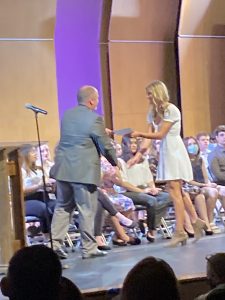TL;DR:
- Think about your legacy and the legacy of your school. What are you leaving behind?
- Know what motivates your people.
- Believe in your people and help them reach their goals.
Honors Night
In 2013, members of my family created a scholarship in honor of my grandparents. Both my grandparents were fixtures in our local high school. For 22+ years, they touched thousands of lives at the high school. As parents, coaches, through the booster club, an employee of the district, grandparents, and community members, they showed their support for the school, its students, and the community. When I attended school there, I thought it was cool my dad’s picture was hanging on the wall celebrating his football team’s success. A couple of years ago, I was there with my family, and I was proud to show them my dad’s picture and the pictures of me from my accomplishments in high school. Last night, I was privileged enough to be allowed to present the Ray and Judy Memorial Scholarship to 2 amazing seniors from my high school.
As leaders, we have to know the legacy of our organization. Both the legacy we inherit and the legacy we embrace, practice, and are leaving. Share on X
Experiencing the Awards Ceremony With My Son
After I was asked to present, my aunt asked if I could get some pictures to post on the website. So I asked my youngest son to attend and take pictures for me. Of course, a 4th grader has many things he would rather do than go to the high school with his dad and take pictures at an awards ceremony. But I know him well enough to know the offer of ice cream afterwards would have me a photographer all scheduled. We sat and watched the ceremony for an hour before it was my turn to present.
During that hour, we watched amazing seniors accept their awards and scholarships. I explained what the students did to earn the awards and scholarships. It was a proud moment to be able to point out the awards I was able to earn. I even explained the award I didn’t win but I really wanted to win. He stated he wanted to win certain awards, and we talked about what he would have to do to reach these goals.
When I was done presenting, we left, and walking to the car he asked me if I was nervous speaking. “Yes,” I told him. I was a little nervous, and he let me know he could tell. Then I asked him how, and he just said, “You didn’t look as confident as normal.” Overall I think he found the night interesting and more enjoyable than he expected. I hope he had fun and was able to see some of the possibilities out there for him.
Legacy
As I reflect upon the experience, I realized there were many lessons I could learn and apply to my leadership. First is the importance of legacy. Not just individual legacy or family legacy. I have grown to understand and embrace the value of institutional legacy. The ceremony exemplified institutional legacy. It showed what the school valued. It demonstrated what the community valued. Our practices demonstrate our values, and they model what we choose to make our legacy.
As leaders, we have to know the legacy of our organization—both the legacy we inherit and the legacy we embrace, practice, and are leaving. We have to be intentional in the legacy we are promoting. Maybe more importantly, we have to communicate the institutional legacy to our people. We have to make sure they know the historical and future legacy of our institution.

Motivation
Just as my son wasn’t excited to attend and photograph the event at first, our people are not always excited to participate, attend, or complete the tasks we ask them to. Unfortunately, we are not always able to bribe them with ice cream like I could with my son. But sometimes ice cream might work.
The key is knowing your people enough to know what motivates them. I knew ice cream would work without a second thought for him, but it doesn’t work for everyone. Everyone has different motivators, and knowing your people allows you to find the best ways to motivate them. We need to know our people and what motivates each of them.
[scroll down to keep reading]Goals
Visualizing possibilities and setting goals is another lesson I was able to reflect upon from last night. My wife coaches high jumpers, and one of her athletes set a goal of 6ft 8in because that was the height he needed to jump to break the school record. She set a bar at that height and let him see it so he could visualize meeting his goal. Last night, I tried to do something similar with my son with some options of goals he could set for himself. As leaders, we need to find ways to show our people what the possibilities are. What they can do. And just as important, we need to believe in them and their abilities to accomplish every goal they set for themselves.
About Raymond Porten
Raymond Porten is a husband to an AMAZING wife, 2 wonderful boys, a principal of an elementary school in northern Illinois, and a Golden Apple Scholar. He spends his free time traveling with his family, cooking with his boys, and he finds the time to co-host 2 podcasts. He’s been in education for 20 years and has worked as a 5th-grade teacher, middle school dean, 7th and 8th-grade social studies teacher, middle school assistant principal, and now as a principal. He believes in the importance of building relationships and of taking every opportunity to lead and make a difference in the world.




